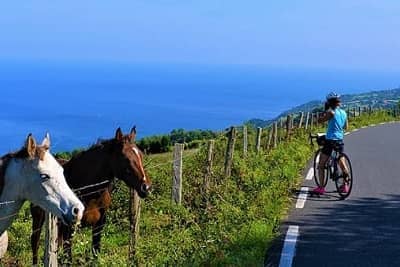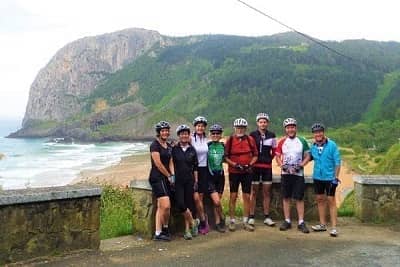Cycle Touring Guide: The History of Rioja
This is the third of three parts in our Complete Guide to Cycling Rioja series. Follow the links below for Part 1
and Part 2.
We also have a guide to Gravel Biking in Rioja, if you would like to find out more about the excellent off-road possibilities in the region.
One of the great things about cycling around the Rioja region is that it is not simply about the wine. In fact, even if you don't drink wine, there is still so much to enjoy in the region, in terms of both scenery and some incredible historic sites.
The Ebro valley was one of the earliest parts of the Iberian peninsula to be conquered by the Romans, and the monuments in Rioja reflect 2,000 years of often turbulent history. There are, of course, far too many to list here, but we can outline some of our favourite and most interesting sights.
These are all easily visitable by bicycle (although castles do tend to be at the top of small hills!). And, because many of these fascinating sites are so close together, it is easy to combine several of them into a single day's riding.
Before the Romans began to systematically conquer the Iberian peninsula in the 2nd and 1st centuries BCE, the Rioja region was inhabited by groups of Celtic tribes. These were warrior like communities that had migrated from central Europe in around 600 BCE and lived in small fortified villages in inland Spain. The most famous of these is the town of Numantia, which is situated around 100km south of Rioja, near to the city of Soria. However, there were also many settlements in the Ebro valley itself. Today, you can visit the remains of the iron-age village Poblado de la Hoya, near the town of Laguardia, and also the remains of Monte Cantabria - situated on a small hill overlooking Logroño.
The Romans began to systematically conquer the Rioja region in the 2nd century BCE, moving inland from their capital in Tarragona. Two of the greatest figures in Roman history - Pompey the Great and Julius Caesar - were both active in the region. Both as they looked to conquer more land for the Roman Republic, and when they fought each other in the civil war which ultimately led to Rome becoming an empire.
The Imperial phase of Rome saw the building of most of the monuments and roads in the Iberian peninsula, particularly under the rules of Augustus, Hadrian and Trajan (the latter two were actually Spanish by birth). One of the best preserved Roman monuments is the beautiful bridge at Cihuri, situated close to Haro. The Roman Villa of Arellano, situated near the town of Los Arcos, is also a fascinating recent discovery, which represented the beginning of the end of Roman rule in Spain.
The Roman Empire did not completely collapse in Rioja, in the same way that it did in Britain and Northern France, but rather gradually transitioned into the Middle Ages under the rule of the Visigoths. The main relic from this period is the UNESCO World Heritage Suso Monastery, which dates from the 6th century - the time when Catholicism was recognised as the official religion for the first time on the Iberian peninsula. Situated in the town of San Millán de la Cogolla, the monastery is one of the best preserved buildings from this period, not just in Spain, but in the whole of Western Europe. It is also recognised as the home of the Spanish language - as it was the first place where the language was written.
The Visigoths were soon kicked out of Spain, however, by the arrival of Arab and Berber Muslims from North Africa. They set up an Emirate which controlled Rioja on and off for nearly two centuries. The most important monument dating from this period is Clavijo Castle, situated a short distance to the south of Logroño. Much of Clavijo Castle was reconstructed in the 10th century, after the Christian kings from Navarre and León had 'reconquered' the area from the Muslims. Indeed, Clavijo is important in Spanish history for being one of the main birthplaces of the reconquista movement - the aim of Christian kings in the north to recapture Spain from the more powerful Muslims in the south. It was at the mythical Battle of Clavijo which legend states took place in 844, where Saint James suddenly appeared on a white horse and led the Christians to victory. This battle, along with other legends around St James and his role in Spain, led to the development of the reconquista as a crusading movement and the birth of the Camino de Santiago pilgrimage route.
Above the door of the church of Santiago la Real in Logroño is a carved depiction of the Battle of Clavijo, with St James defeating the muslim army. The battle was believed to have been a real event for centuries in the Middle Ages and had a significant impact on Spanish culture and history.
The Camino has been walked since the 9th century, becoming a major industry in the 11th-13th centuries, where it attracted knights, pilgrims and clergy from all over Europe. This in turn, led to the construction of hospitals, monasteries and convents (often used as hotels) across the Rioja region. In addition, bridges and roads were built to ease the journey for pilgrims - which made the towns along the Camino de Santiago some of the most connected, and therefore most commercialized, in the Christian part of Spain.
In Rioja, the town of Santo Domingo de la Calzada was purpose built almost exactly one thousand years ago, for pilgrims on the Camino de Santiago, and continued to grow through the Middle Ages. The beautiful historic centre is home to stunning buildings, narrow streets and elegant squares which originally were intended to both provide comfort and to impress influential travellers.
As well as Santo Domingo, the towns of Logroño, Los Arcos and Nájera all owe a considerable amount of their development to the influence of the Camino. For more information about the Camino, check out our more indepth guide to the Camino de Santiago.
Rioja was also sandwiched between several kingdoms who were not always on the best of terms with each other. Castile, León, Navarre, Aragón, France, Al-Andalus (Muslim Spain) and even England (during the 100 Years War) all made claims to part or all of the region at various times, during the turbulent 11th to 15th centuries.
One legacy of this is a huge amount of castles and fortifications, many of which are still standing and visitable in Rioja today. Among the most impressive are the 11th century castle of San Vicente de la Sonsierra - free to visit and offering spectacular views over the Ebro. Other castles include Sajazarra, Briones, Clavijo, Anguciana, Davalillo and Torremontalbo, with most of these easily combined in a single day riding along the Ebro River - which was often the border between kingdoms thanks to the natural defence it offered.
In addition to castles, there are some delightful fortified towns, replete with narrow lanes, quaint churches and imposing walls. The most impressive is Laguardia, with a stunning compact old town perched on top of a small hill. Viana, Los Arcos, Logroño and Najera also boast beautifully preserved and fortified old town.
However, Spain increasingly began to focus its belligerent energy outside the Iberian peninsula. It expanded its influence rapidly in the Americas and was often in conflict with its main European rivals - England, France and the Ottoman Empire. Rioja was largely tranquil during these times, although impressive monuments (particularly churches and bridges) continued to be developed, notable examples of which are in smaller villages such as Paganos, Azofra and Haro.
The 19th and 20th centuries were more turbulent times for Rioja, as for the rest of Spain. The period began with an invasion from Napoleon and continued with the Carlist Wars and the Spanish Civil War. Rioja was not a major protagonist in most of these. Unlike in the Middle Ages, it was no longer strategically important, and the focus was more on the industrial powerhouses such as Catalonia, Valencia and the Basque Coast.
It was in this period that the wine industry in Rioja really underwent a renaissance. In the late 19th century a phylloxera outbreak destroyed many of the vineyards in the French region of Bordeaux. And it was the migration of winemakers from Bordeaux to nearby Rioja, where the disease had not spread to, that saw the founding of many of the most famous and highly regarded wineries. The immigrants from Bordeaux brought with them new techniques and practices which helped to transform the industry.
On our guided cycling tours to Rioja we stay in four hotels which are simply incredible for their history. In Haro, Hotel Los Agustinos, was originally a convent built in the 14th century. Since then, at various times, it has also been a military headquarters and a prison. It is a stunning building, with the central cloisters now forming a bar and relaxing area.
Another former convent that we stay in regularly is the Parador Hotel in Santo Domingo de la Calzada - a beautiful building with a maze of rooms and courtyards to explore inside. Elsewhere in Santo Domingo is another Parador hotel situated in a former 12th century hospital.
In Laguardia you are spoilt for choice, with Hospederia de los Parajes, Posada de Migueloa and Hotel Castillo el Collado all situated in the heart of the old town and housed in stunning buildings, all with many hundreds of years of history. They also have underground wine cellars to explore, and some of the most impressive entrance doors and patios that you could wish to see!
In Logroño, Hotel Calle Mayor is our favourite - situated right in the historic centre in a 16th century palace. Another special place is in San Millán de la Cogolla, where you can stay in the actual UNESCO World Heritage listed Yuso monastery (although it is generally only open on weekends or in summer). This is similar to the former convents in Haro and Santo Domingo, but the rooms are a little more spartan, perhaps to give you a more authentic monastic experience!
This is an example of a cycling route through the Rioja region which visits many of the most interesting historic sites including: Logroño old town, Laguardia, Poblado de la Hoya, San Vicente Castle, Roman Bridge at Cihuri, Santo Domingo de la Calzada, and Suso Monastery. In addition, there are many more interesting places on route that you would stumble across, and of course, such a route would also pass by many of the best wineries.
This tour is designed to be spread across multiple days and is around 140km (90 miles) long, although there are plenty of interesting places to explore along the way, so we are sure you will ride more than that.
The route starts in Logroño and finishes in Najera and follows quiet roads, 95% of which are fully paved. Ideal places to stay include Logroño, Santo Domingo, Haro and Laguardia. You can view the full details by clicking the links on the map, and can download it as a GPS track.
Part of this route forms the basis of both our guided and self guided cycling tours to the region. If you are interested in visiting the region, please check out the linked itineraries, or continue scrolling down the page for more information.
Please note that all of the suggestions and routes on this page are for information purposes only and are to be used at your own risk. In particular remember not to cycle after consuming more than the legal limit of alcohol!!
And, on that very subject; you may be interested in Part 2 of our guide to cycling in Rioja - where we look at the wineries of the region.
We also have a guide to Gravel Biking in Rioja, if you would like to find out more about the excellent off-road possibilities in the region.
One of the great things about cycling around the Rioja region is that it is not simply about the wine. In fact, even if you don't drink wine, there is still so much to enjoy in the region, in terms of both scenery and some incredible historic sites.
The Ebro valley was one of the earliest parts of the Iberian peninsula to be conquered by the Romans, and the monuments in Rioja reflect 2,000 years of often turbulent history. There are, of course, far too many to list here, but we can outline some of our favourite and most interesting sights.
These are all easily visitable by bicycle (although castles do tend to be at the top of small hills!). And, because many of these fascinating sites are so close together, it is easy to combine several of them into a single day's riding.
Rioja in Ancient Times
Before the Romans began to systematically conquer the Iberian peninsula in the 2nd and 1st centuries BCE, the Rioja region was inhabited by groups of Celtic tribes. These were warrior like communities that had migrated from central Europe in around 600 BCE and lived in small fortified villages in inland Spain. The most famous of these is the town of Numantia, which is situated around 100km south of Rioja, near to the city of Soria. However, there were also many settlements in the Ebro valley itself. Today, you can visit the remains of the iron-age village Poblado de la Hoya, near the town of Laguardia, and also the remains of Monte Cantabria - situated on a small hill overlooking Logroño.
The Romans began to systematically conquer the Rioja region in the 2nd century BCE, moving inland from their capital in Tarragona. Two of the greatest figures in Roman history - Pompey the Great and Julius Caesar - were both active in the region. Both as they looked to conquer more land for the Roman Republic, and when they fought each other in the civil war which ultimately led to Rome becoming an empire.
The Imperial phase of Rome saw the building of most of the monuments and roads in the Iberian peninsula, particularly under the rules of Augustus, Hadrian and Trajan (the latter two were actually Spanish by birth). One of the best preserved Roman monuments is the beautiful bridge at Cihuri, situated close to Haro. The Roman Villa of Arellano, situated near the town of Los Arcos, is also a fascinating recent discovery, which represented the beginning of the end of Roman rule in Spain.
The Visigoths and Medieval Rioja
The Roman Empire did not completely collapse in Rioja, in the same way that it did in Britain and Northern France, but rather gradually transitioned into the Middle Ages under the rule of the Visigoths. The main relic from this period is the UNESCO World Heritage Suso Monastery, which dates from the 6th century - the time when Catholicism was recognised as the official religion for the first time on the Iberian peninsula. Situated in the town of San Millán de la Cogolla, the monastery is one of the best preserved buildings from this period, not just in Spain, but in the whole of Western Europe. It is also recognised as the home of the Spanish language - as it was the first place where the language was written.
The Visigoths were soon kicked out of Spain, however, by the arrival of Arab and Berber Muslims from North Africa. They set up an Emirate which controlled Rioja on and off for nearly two centuries. The most important monument dating from this period is Clavijo Castle, situated a short distance to the south of Logroño. Much of Clavijo Castle was reconstructed in the 10th century, after the Christian kings from Navarre and León had 'reconquered' the area from the Muslims. Indeed, Clavijo is important in Spanish history for being one of the main birthplaces of the reconquista movement - the aim of Christian kings in the north to recapture Spain from the more powerful Muslims in the south. It was at the mythical Battle of Clavijo which legend states took place in 844, where Saint James suddenly appeared on a white horse and led the Christians to victory. This battle, along with other legends around St James and his role in Spain, led to the development of the reconquista as a crusading movement and the birth of the Camino de Santiago pilgrimage route.
Above the door of the church of Santiago la Real in Logroño is a carved depiction of the Battle of Clavijo, with St James defeating the muslim army. The battle was believed to have been a real event for centuries in the Middle Ages and had a significant impact on Spanish culture and history.
Camino de Santiago & The Middle Ages
The most important impact of the various legends of St James was the development of the Camino de Santiago (Way of St James) pilgrimage route, which passes through the heart of Rioja. Today it is one of the most popular long distance hiking routes in the world, with people undertaking it for a variety of spiritual and non-spiritual (challenge, scenery, fitness etc...) reasons.The Camino has been walked since the 9th century, becoming a major industry in the 11th-13th centuries, where it attracted knights, pilgrims and clergy from all over Europe. This in turn, led to the construction of hospitals, monasteries and convents (often used as hotels) across the Rioja region. In addition, bridges and roads were built to ease the journey for pilgrims - which made the towns along the Camino de Santiago some of the most connected, and therefore most commercialized, in the Christian part of Spain.
In Rioja, the town of Santo Domingo de la Calzada was purpose built almost exactly one thousand years ago, for pilgrims on the Camino de Santiago, and continued to grow through the Middle Ages. The beautiful historic centre is home to stunning buildings, narrow streets and elegant squares which originally were intended to both provide comfort and to impress influential travellers.
As well as Santo Domingo, the towns of Logroño, Los Arcos and Nájera all owe a considerable amount of their development to the influence of the Camino. For more information about the Camino, check out our more indepth guide to the Camino de Santiago.
Christian Castles and Kingdoms
While the Camino de Santiago represents the spiritual and, to some extent, commercial side of the Middle Ages, the many castles in the region highlight the political and military struggles. Rioja was a desirable area, with fertile lands along the Ebro, and excellent communication with other regions thanks to both the Camino de Santiago and the river itself.Rioja was also sandwiched between several kingdoms who were not always on the best of terms with each other. Castile, León, Navarre, Aragón, France, Al-Andalus (Muslim Spain) and even England (during the 100 Years War) all made claims to part or all of the region at various times, during the turbulent 11th to 15th centuries.
One legacy of this is a huge amount of castles and fortifications, many of which are still standing and visitable in Rioja today. Among the most impressive are the 11th century castle of San Vicente de la Sonsierra - free to visit and offering spectacular views over the Ebro. Other castles include Sajazarra, Briones, Clavijo, Anguciana, Davalillo and Torremontalbo, with most of these easily combined in a single day riding along the Ebro River - which was often the border between kingdoms thanks to the natural defence it offered.
In addition to castles, there are some delightful fortified towns, replete with narrow lanes, quaint churches and imposing walls. The most impressive is Laguardia, with a stunning compact old town perched on top of a small hill. Viana, Los Arcos, Logroño and Najera also boast beautifully preserved and fortified old town.
United Spain & Modern Rioja
After the unification of Spain under Queen Isabella and King Ferdinand in the late 15th century, Rioja became a slightly more harmonious place. There were still uprisings occasionally, including one which led to King Philip II destroying the castle at nearby Estella Lizarra. The infamous Inquisition was also active at times in Rioja; one of the most gruesome autos-de-fé took place at Logroño in 1610 where several people accused of witchcraft and heresy were condemned.However, Spain increasingly began to focus its belligerent energy outside the Iberian peninsula. It expanded its influence rapidly in the Americas and was often in conflict with its main European rivals - England, France and the Ottoman Empire. Rioja was largely tranquil during these times, although impressive monuments (particularly churches and bridges) continued to be developed, notable examples of which are in smaller villages such as Paganos, Azofra and Haro.
The 19th and 20th centuries were more turbulent times for Rioja, as for the rest of Spain. The period began with an invasion from Napoleon and continued with the Carlist Wars and the Spanish Civil War. Rioja was not a major protagonist in most of these. Unlike in the Middle Ages, it was no longer strategically important, and the focus was more on the industrial powerhouses such as Catalonia, Valencia and the Basque Coast.
It was in this period that the wine industry in Rioja really underwent a renaissance. In the late 19th century a phylloxera outbreak destroyed many of the vineyards in the French region of Bordeaux. And it was the migration of winemakers from Bordeaux to nearby Rioja, where the disease had not spread to, that saw the founding of many of the most famous and highly regarded wineries. The immigrants from Bordeaux brought with them new techniques and practices which helped to transform the industry.
Historic Hotels - A Cultural Heritage
One of the great things about riding around the Rioja region for fans of history, is that there are many hotels housed in stunning historical buildings. This is particularly true in towns such as Haro, Santo Domingo, Logroño and Laguardia, but also in some smaller villages. Below are some of the most interesting, but there are many more!On our guided cycling tours to Rioja we stay in four hotels which are simply incredible for their history. In Haro, Hotel Los Agustinos, was originally a convent built in the 14th century. Since then, at various times, it has also been a military headquarters and a prison. It is a stunning building, with the central cloisters now forming a bar and relaxing area.
Another former convent that we stay in regularly is the Parador Hotel in Santo Domingo de la Calzada - a beautiful building with a maze of rooms and courtyards to explore inside. Elsewhere in Santo Domingo is another Parador hotel situated in a former 12th century hospital.
In Laguardia you are spoilt for choice, with Hospederia de los Parajes, Posada de Migueloa and Hotel Castillo el Collado all situated in the heart of the old town and housed in stunning buildings, all with many hundreds of years of history. They also have underground wine cellars to explore, and some of the most impressive entrance doors and patios that you could wish to see!
In Logroño, Hotel Calle Mayor is our favourite - situated right in the historic centre in a 16th century palace. Another special place is in San Millán de la Cogolla, where you can stay in the actual UNESCO World Heritage listed Yuso monastery (although it is generally only open on weekends or in summer). This is similar to the former convents in Haro and Santo Domingo, but the rooms are a little more spartan, perhaps to give you a more authentic monastic experience!
Historic Rioja Cycling Route
This is an example of a cycling route through the Rioja region which visits many of the most interesting historic sites including: Logroño old town, Laguardia, Poblado de la Hoya, San Vicente Castle, Roman Bridge at Cihuri, Santo Domingo de la Calzada, and Suso Monastery. In addition, there are many more interesting places on route that you would stumble across, and of course, such a route would also pass by many of the best wineries.
This tour is designed to be spread across multiple days and is around 140km (90 miles) long, although there are plenty of interesting places to explore along the way, so we are sure you will ride more than that.
The route starts in Logroño and finishes in Najera and follows quiet roads, 95% of which are fully paved. Ideal places to stay include Logroño, Santo Domingo, Haro and Laguardia. You can view the full details by clicking the links on the map, and can download it as a GPS track.
Part of this route forms the basis of both our guided and self guided cycling tours to the region. If you are interested in visiting the region, please check out the linked itineraries, or continue scrolling down the page for more information.
Please note that all of the suggestions and routes on this page are for information purposes only and are to be used at your own risk. In particular remember not to cycle after consuming more than the legal limit of alcohol!!
And, on that very subject; you may be interested in Part 2 of our guide to cycling in Rioja - where we look at the wineries of the region.
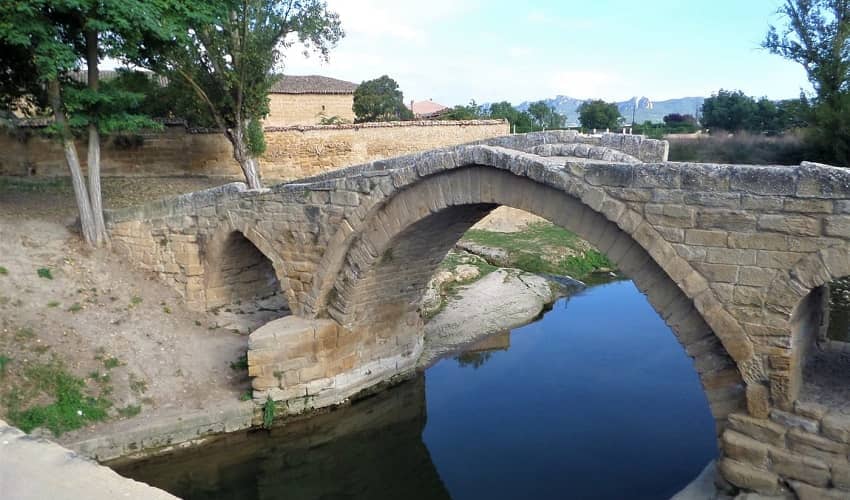
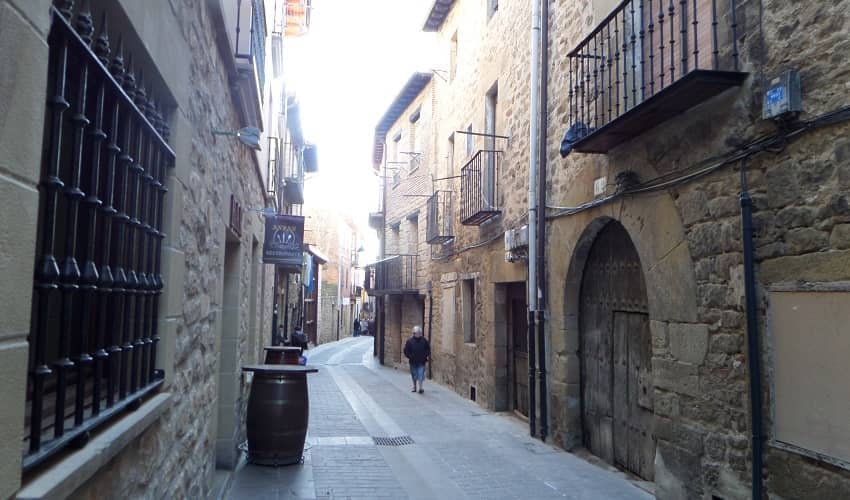
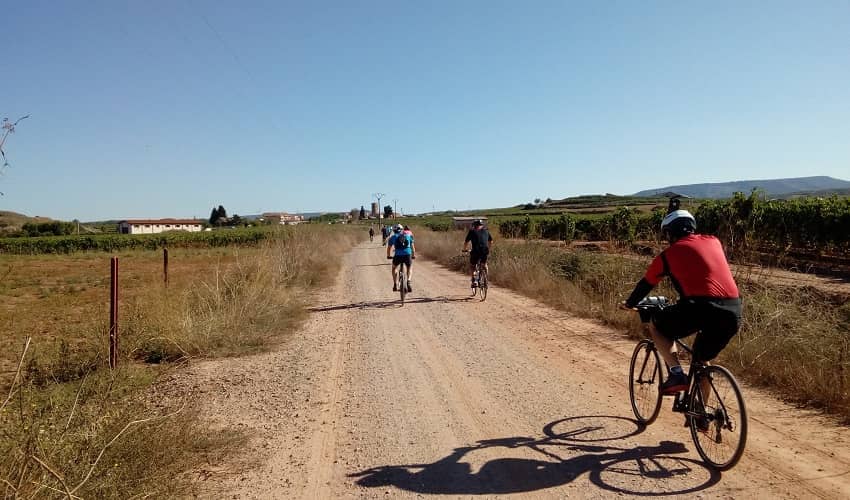
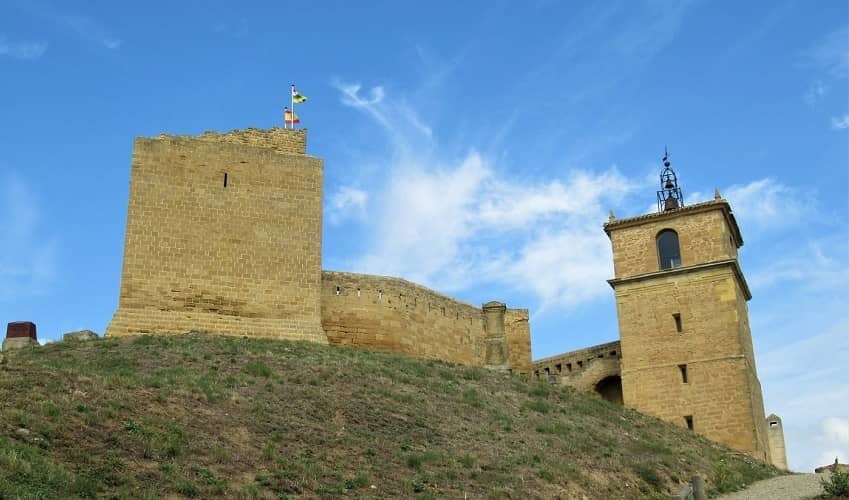
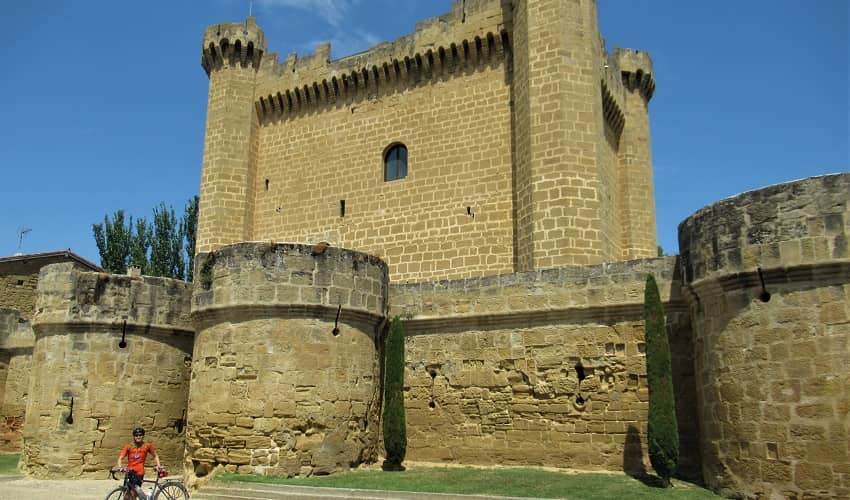
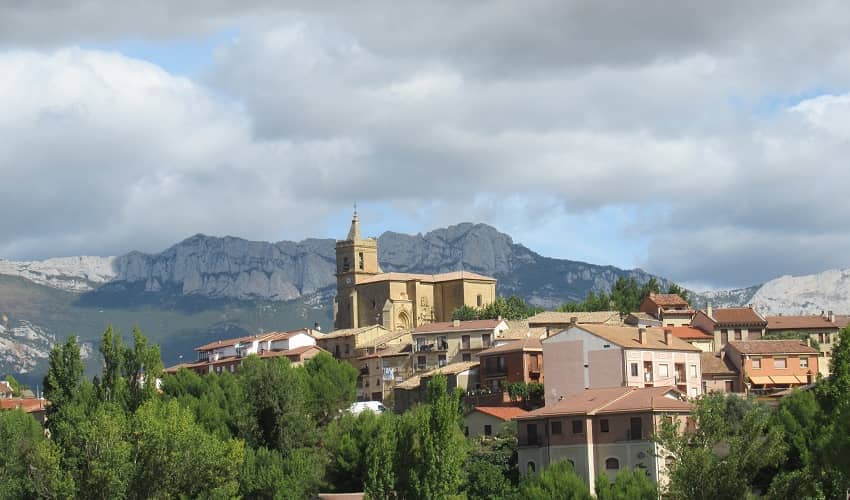
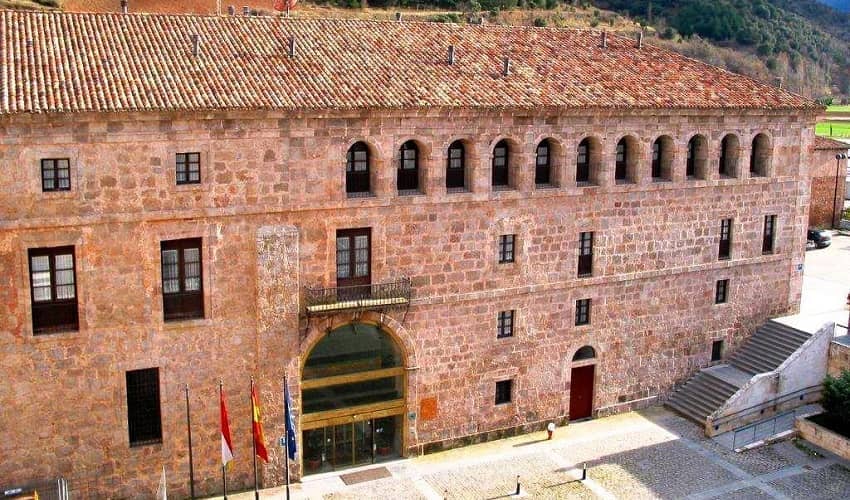
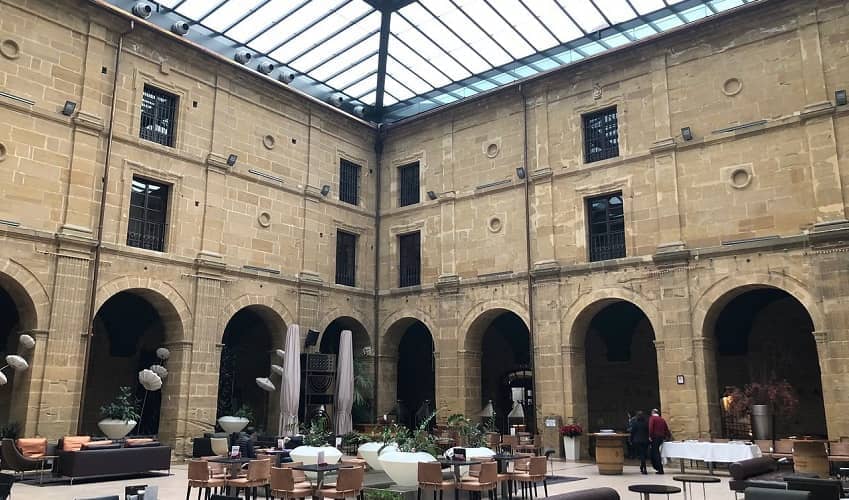
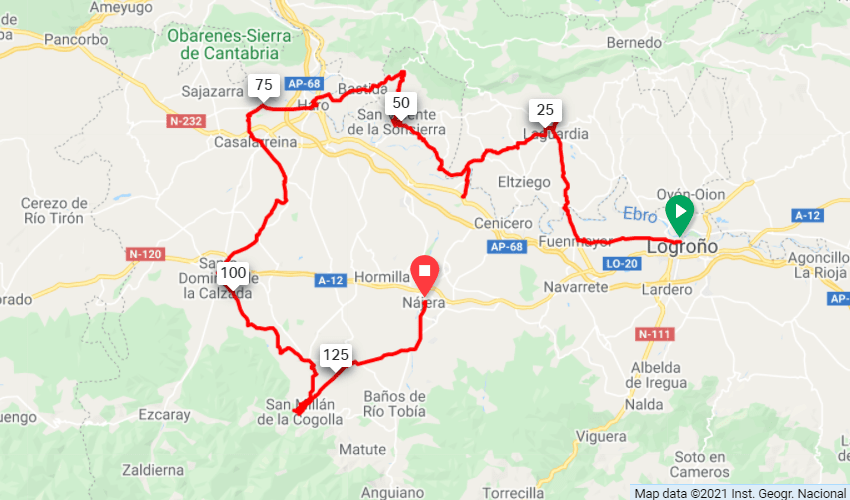
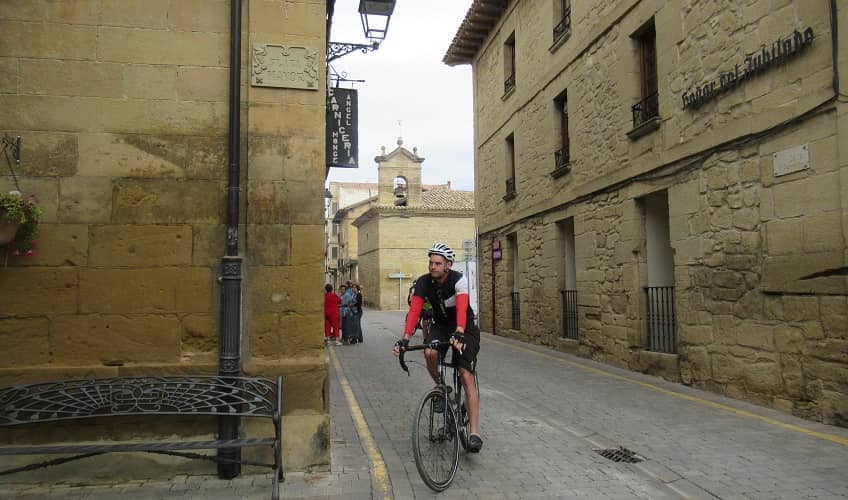
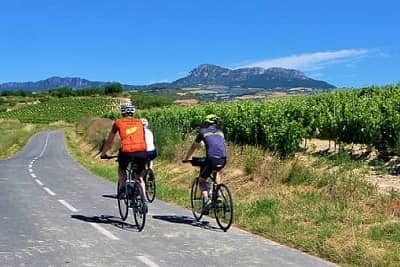

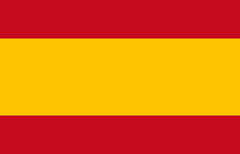 Spain
Spain
